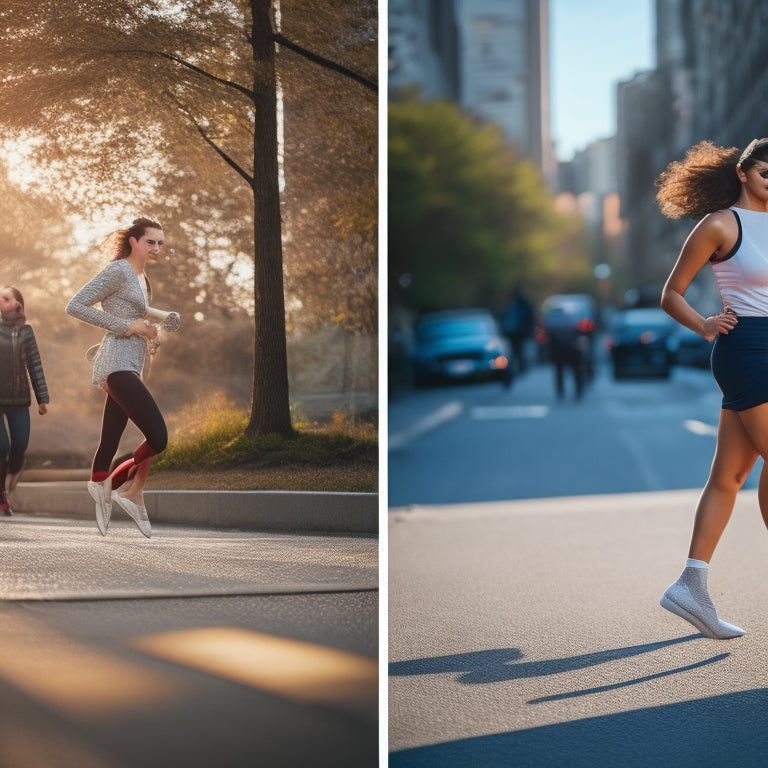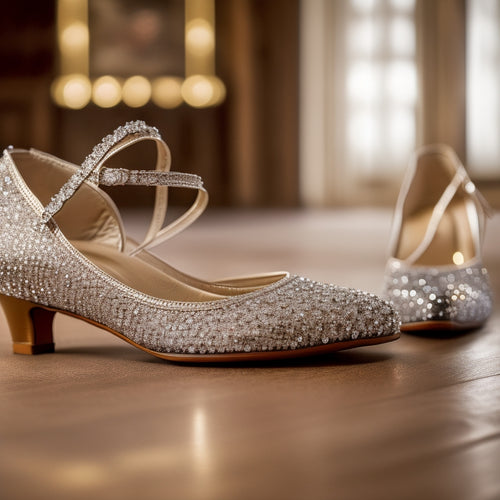
Can You Walk in Dancing Shoes?
Share
You can walk in dancing shoes, but it's important to take into account the type of shoe, design, and materials used. Ballet shoes, jazz shoes, ballroom shoes, and turning shoes serve specific purposes, so choose wisely. Cushioning, support, and heel height impact your posture and movement. Weight and balance factors also affect your overall performance. While you can walk in dancing shoes, it's vital to understand the mechanics of walking vs. dancing to avoid injuries. By exploring the world of dancing shoes, you'll discover the perfect blend of style, comfort, and functionality, and reveal the secrets to moving with confidence and precision - and there's much more to uncover.
Key Takeaways
• Dancing shoes are designed for specific dance styles, not walking, and may not provide necessary support or cushioning for everyday walking.
• Weight and balance factors in dancing shoes can affect overall performance, but may not be suitable for walking due to differing mechanics.
• While some dancing shoes can be worn as casual wear, they may not be designed for walking and may lack necessary arch support or cushioning.
• Mastering fundamental mechanics of walking versus dancing is crucial, and wearing dancing shoes for walking may not provide the necessary comfort or support.
• It's essential to choose the right shoes for the specific activity, as dancing shoes are designed for dancing and may not be the best choice for walking.
Types of Dancing Shoes Matter
When you step into the world of dance, the type of shoe on your foot becomes an essential factor in your performance, as different styles of dance require specific shoes that can handle the unique demands of each genre.
You'll find that ballet shoes, with their soft, flexible soles, are perfect for gliding across the dance floor.
In contrast, jazz shoes, with their sturdy, supportive design, can withstand the high-energy movements of jazz and hip-hop.
The history of dance shoes is a fascinating one, with each style evolving to meet the needs of its respective dance form.
From the smooth, leather soles of ballroom shoes to the turning shoes of contemporary dance, every shoe is designed to work in harmony with the dance floor, allowing you to move freely and express yourself with precision and confidence.
Design and Comfort Considerations
As you step into the world of dancing shoes, you'll quickly realize that design and comfort considerations are essential to your overall performance.
You'll want to pay close attention to heel height, as it can significantly impact your posture and movement.
From there, you'll need to take into account the type of cushioning and support you need, as well as the upper material that will keep your feet happy and healthy.
Heel Height Matters
How do you balance style and comfort when the heel height of your dancing shoes can make or break your performance? You want to exude confidence and poise, but you also need to feel comfortable and supported. The right heel height can give you Heel Confidence, allowing you to move freely and focus on your dance moves.
Here's a breakdown of common heel heights and their characteristics:
| Heel Height | Characteristics |
|---|---|
| 1-2 inches | Low to moderate heel, great for beginners or casual dancing |
| 2-3 inches | Moderate heel, suitable for most dance styles and occasions |
| 3-4 inches | Higher heel, ideal for more advanced dancers or special occasions |
| 4-5 inches | Very high heel, recommended for experienced dancers or specific dance styles |
| 5+ inches | Extremely high heel, not recommended for most dancers |
Cushioning and Support
You'll want to make sure your dancing shoes provide the right amount of cushioning and support to keep your feet happy and healthy throughout your performance. Cushioning is essential for sole protection, absorbing shock and reducing the impact on your joints. Look for shoes with thick, responsive midsoles that will cradle your feet with each step.
Midfoot cradling is also important, providing lateral support and stability as you move. A well-designed midfoot will keep your foot in place, preventing excessive pronation or supination. By prioritizing cushioning and support, you'll be free to focus on your performance, unencumbered by discomfort or distraction.
With the right shoes, you'll be able to move with confidence and freedom, expressing your full artistic potential.
Upper Material Choices
When selecting the perfect dancing shoes, the upper material becomes a critical factor in balancing design aesthetics with comfort and performance considerations. You want a material that not only looks great but also provides the right amount of support and flexibility.
Breathable mesh is an excellent choice, allowing for airflow and moisture wicking to keep your feet cool and dry. Synthetic weaves, on the other hand, offer durability and resistance to abrasion. You'll appreciate the flexibility and lightweight feel of these materials as you move across the dance floor.
Material Differences Explained
Dancing shoes' materials greatly impact their performance, and you'll find that manufacturers often blend synthetic and natural materials to achieve a perfect balance of durability, flexibility, and style. You'll notice that soles are typically made from rubber or polyurethane, which provides excellent sole durability. These materials are often combined with fabric blends, such as suede, canvas, or leather, to create a comfortable and breathable upper.
This fusion of materials allows for a comfortable fit, while also providing the necessary support for your feet. When walking in dancing shoes, you'll appreciate the flexibility and cushioning that these materials provide. By understanding the material differences, you'll be able to choose the perfect pair for your dancing needs.
Support and Stability Issues
As you slip into your dancing shoes, you're not just thinking about style - you're also considering the critical support and stability features that'll keep you moving comfortably.
It's time to examine the essential points that'll keep you upright and rolling: preventing ankle rolls, ensuring proper arch alignment, and cushioning your footbed for best shock absorption.
Ankle Roll Prevention
You'll find that even slight ankle rolls can greatly impact your overall stability, which is why incorporating ankle-strengthening exercises and supportive footwear into your routine is essential for preventing these debilitating setbacks.
By incorporating exercises that target the intrinsic muscles of your feet, such as toe curls and heel raises, you'll be better equipped to handle the demands of dancing in shoes designed for walking.
Additionally, consider using ankle wraps to provide extra support and stability. This will enable you to move with confidence, knowing your ankles are secure.
With strong ankles and supportive footwear, you'll be free to move without worrying about rolling your ankle, allowing you to focus on the joy of movement.
Proper Arch Alignment
Properly aligned arches serve as the foundation of a stable foundation, transmitting forces evenly and efficiently, allowing you to move with precision and control. When your arches are properly aligned, you'll experience reduced fatigue and discomfort, as your feet are able to absorb shock and distribute pressure evenly. On the other hand, poor arch alignment can lead to issues like foot pronation, where your foot rolls inward, putting unnecessary stress on your ankles and legs.
| Arch Alignment | Effects on Movement |
|---|---|
| Proper Alignment | Even force distribution, reduced fatigue |
| Overpronation | Increased stress on ankles and legs |
| Underpronation | Increased stress on outer ankle and knee |
| Neutral Alignment | Best movement, reduced discomfort |
| Misaligned Arches | Increased risk of injury and fatigue |
Footbed Cushioning Matters
With every step, your footbed cushioning plays a vital role in absorbing shock and providing the necessary support and stability for your feet to function at their best. This is especially important when walking in dancing shoes, as they often feature a unique sole shape that can affect your arch type.
To guarantee maximum comfort and performance, consider the following key factors:
-
Cushioning material: Look for high-quality materials that provide excellent shock absorption and durability.
-
Cushioning density: A denser cushioning material can provide better support, but may compromise on flexibility.
-
Cushioning distribution: Even distribution of cushioning material is essential to prevent pressure points and hotspots.
Weight and Balance Factors
As you step into your dancing shoes, every ounce of weight and balance factor comes into play, greatly impacting your overall performance.
You see, your center gravity plays an important role in maintaining balance, and even the slightest shift can throw you off. That's why mastering balance techniques is vital.
By distributing your weight evenly and keeping your center gravity low, you'll be able to move with confidence and precision.
Remember, it's all about finding that sweet spot where your body is in harmony with your shoes.
With practice, you'll be able to glide across the floor with ease, feeling free and unencumbered.
Walking Vs Dancing Mechanics
You switch into dance mode by abandoning the heel-to-toe walking motion and adopting a rolling action that originates from the ball of your foot. This fundamental shift in mechanics is vital for dancing in shoes designed for movement. A biomechanics analysis reveals that dancing requires a more upright posture, with a focus on generating power from your core and legs. This allows you to move with freedom and fluidity.
Here are three key differences between walking and dancing mechanics:
-
Foot strike pattern: Dancing involves a midfoot or forefoot strike, whereas walking typically involves a heel strike.
-
Weight transfer: Dancing requires a more dynamic weight transfer, with a focus on generating power and momentum.
-
Rhythmic patterns: Dancing involves complex rhythmic patterns, which are essential for creating movement and expression.
Practice Vs Everyday Use
By mastering the fundamental mechanics of dancing, you're ready to explore the distinction between practicing dance techniques and incorporating them into your everyday life. You've honed your skills, now it's time to integrate them into your daily routine.
Ask yourself, can you wear dancing shoes as casual wear? The answer is yes! You can smoothly shift from practice to everyday use. Imagine incorporating dance-inspired movements into your daily commute or grocery shopping trip. It's about blending freedom of movement into your daily routine.
Personal Comfort and Preference
With every step, your personal comfort and preference play a significant role in determining the perfect blend of style and functionality in your dancing shoes.
As you slip into your dancing shoes, you're not just contemplating the dance floor – you're making a statement about your personal style.
Here are three key factors to take into account:
-
Body type: Your body shape and size influence the style that suits you best.
-
Fashion sense: Your personal taste in fashion can make or break your overall look.
-
Mood booster: Dancing shoes can be a self-expression tool, elevating your mood and confidence.
Your dancing shoes are an extension of your personality, reflecting your unique flavor of self-expression. By choosing the right pair, you're not just comfortable – you're liberated to express yourself freely.
Safety Concerns and Risks
As you step into your dancing shoes, you're not just thinking about style - you're also considering the potential risks.
You're aware that tripping hazards, injury risk factors, and slip and fall dangers can quickly turn a fun night out into a painful memory.
Tripping Hazards Ahead
You're more likely to trip and fall when walking in dancing shoes than you might think, especially since the shoes' sleek soles can turn any ordinary floor into a slippery slope. As you walk, you'll need to be extra cautious to avoid hazards that can send you tumbling.
Here are three tripping hazards to watch out for:
-
Floor Clutter: Cords, wires, and scattered objects can create a treacherous path, making it easy to trip and fall.
-
Lighting Issues: Poor lighting can hide obstacles, making it difficult to see what's ahead, and increasing your risk of tripping.
-
Uneven Surfaces: Uneven, slippery, or irregularly shaped floors can throw you off balance, leading to a nasty fall.
Stay alert, and you'll be more likely to avoid these hazards and walk safely in your dancing shoes.
Injury Risk Factors
When dancing shoes meet hazardous flooring, your risk of injury skyrockets, especially if you're not aware of the specific risks that can send you crashing to the ground.
As you walk in dancing shoes, your fitness levels and body type play a significant role in determining your injury risk factors. If you're new to dancing or have a lower fitness level, you're more prone to injuries due to fatigue and decreased coordination.
Additionally, your body type can affect your balance and stability, making it vital to take into account your individual needs when choosing dancing shoes.
Slip and Fall Dangers
Safety risks skyrocket when dancing shoes meet slick, uneven, or wet flooring, and you're more likely to slip and fall if you're not prepared to tackle these hazardous conditions head-on.
As you take on the dance floor, remember that floor hazards can be lurking around every corner. To stay safe, keep an eye out for:
-
Wet spills: Be cautious of slippery substances like water, oil, or cleaning products that can send you flying.
-
Uneven flooring: Watch out for cracks, potholes, or loose tiles that can trip you up.
-
Cords and wires: Avoid getting tangled up in cords or wires that can cause you to stumble and fall.
Alternative Options Available
Embracing alternative options available, dancers can break free from the constraints of traditional dance shoes and explore innovative solutions that cater to their unique needs and preferences.
You can opt for street style-inspired shoes that merge fashion trends with comfort. Casual wear and leisure shoes can be perfect for outdoor activities, allowing you to move freely while maintaining style.
Alternatively, fitness options like sneakers or trainers can provide the necessary support and flexibility for your lifestyle choices.
By venturing beyond traditional dance shoes, you can find footwear that complements your individuality and enables you to take your passion for dance beyond the studio.
With these alternatives, you can walk, run, and dance your way to freedom and self-expression.
Frequently Asked Questions
Can I Wear Dancing Shoes for Long Walks or Hikes?
You can't wear dancing shoes for long walks or hikes; they lack trail comfort and support. Save them for City strolls, but for rugged adventures, opt for sturdy, breathable shoes that prioritize your foot's freedom and comfort.
Do Dancing Shoes Provide Enough Arch Support for Daily Use?
"When in doubt, doubt your shoes!" Remember, you deserve daily comfort. Dancing shoes often lack sufficient arch support, especially for unique arch types. Shoe materials and heel height can exacerbate foot pronation issues, so prioritize your foot freedom!
Are Dancing Shoes Suitable for People With Foot or Ankle Issues?
When tackling foot or ankle issues, you'll want to prioritize comfort and support; however, dancing shoes might not be the best choice, as they can exacerbate foot pain and ankle strains if not properly fitted or designed for your specific needs.
Can Dancing Shoes Be Worn With Orthotics or Insoles?
You can definitely wear dancing shoes with orthotics or insoles, especially with customized insoles that provide special accommodations for your unique foot needs, giving you the freedom to dance with comfort and confidence!
Do Dancing Shoes Have a Break-In Period Like Regular Shoes?
When you slip into dancing shoes, anticipate a break-in period, depending on the sole flexibility and shoe material. Wear testing reveals comfort zones, and sizing options guarantee a snug fit with ample toe room, freeing you to move with confidence!
Related Posts
-

Why Digital Solutions Are a Game-Changer
By integrating digital solutions into your operations, you can revolutionize your workflows, discover new revenue str...
-

Best Ballroom Dance Shoes for International Style
When you're selecting the best ballroom dance shoes for International Style, focus on essential features like grip, c...
-

Sfballet: Enhancing Dance Education With E-Papers
SF Ballet is pioneering dance education through innovative e-papers, leveraging digital technology to provide high-qu...


